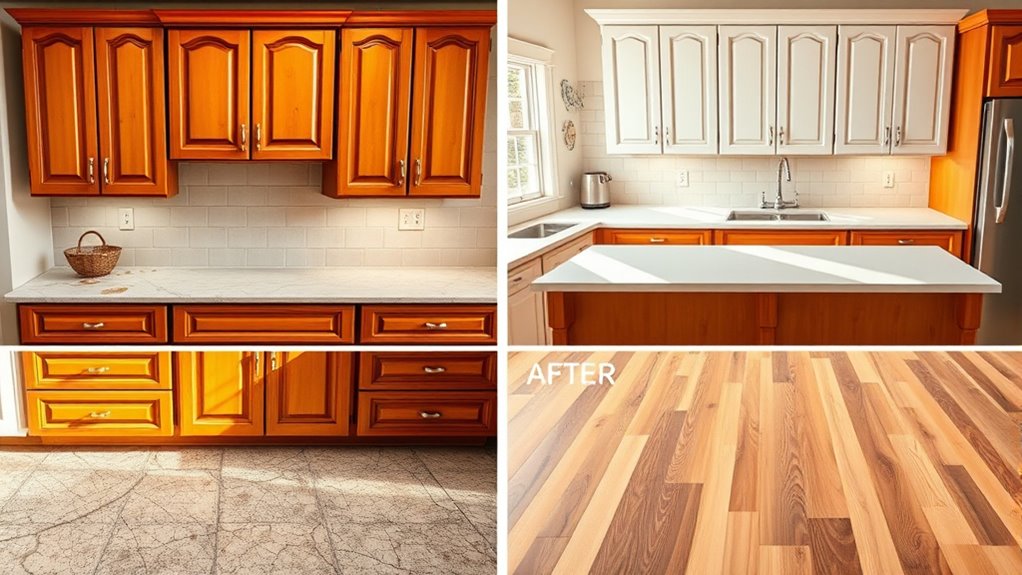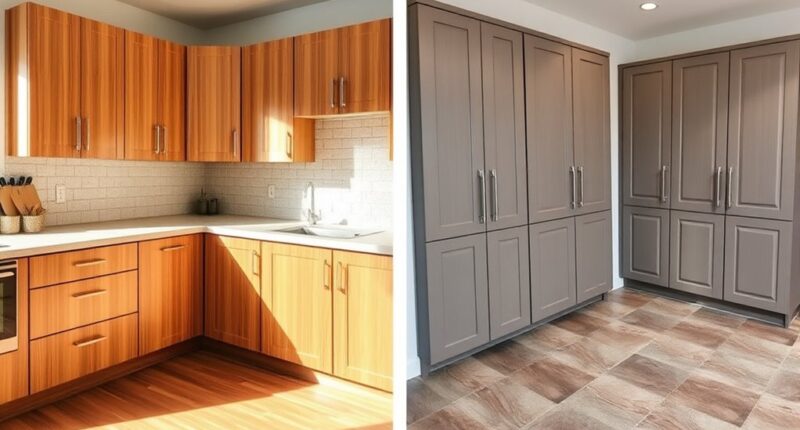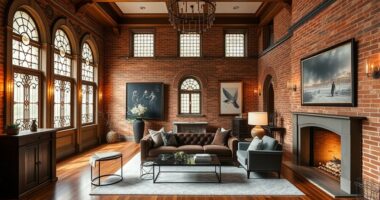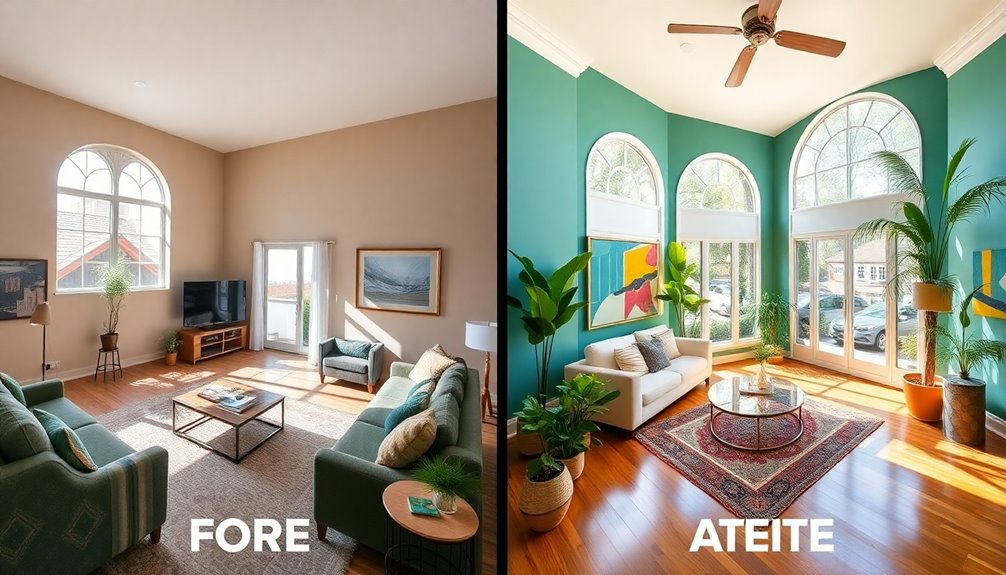When choosing between resurfacing and replacing your cabinets, counters, and floors, consider your aesthetic goals and budget. Resurfacing offers a fresh look while preserving your space’s charm, perfect for minor updates and adding a new color or texture. Replacing, however, allows for a complete transformation—better durability and style options, ideal for extensive damage or a bold change. Exploring both options further can help you craft a stunning, personalized space that reflects your vision.
Key Takeaways
- Resurfacing preserves existing cabinets, counters, or floors while applying new finishes, ideal for minor updates and cost savings.
- Replacing involves removing old surfaces and installing new materials, suitable for severe damage or complete style changes.
- Resurfacing is faster and more budget-friendly but may have limited durability compared to replacement.
- Replacing offers customization with new styles, materials, and improved longevity but requires more time and higher costs.
- The choice depends on surface condition, renovation goals, and budget constraints for cabinets, counters, and floors.

When it comes to restoring worn or damaged surfaces, you face a choice that can dramatically influence both the look and longevity of your space: resurfacing or replacing. Imagine standing in your kitchen, eyeing those tired cabinets with peeling paint or scratched countertops that no longer reflect your style. Now picture transforming them—not by gutting the entire room, but by carefully renewing what’s already there. Resurfacing offers a way to breathe new life into your surfaces, highlighting their beauty with a fresh coat of paint, veneer, or specialized coatings. It’s about enhancing the existing structure, accentuating the grain of wood or the sleekness of stone, rather than tearing it out. With resurfacing, you get to preserve the character of your space while subtly elevating its aesthetic. The process involves meticulous preparation—sanding, cleaning, and priming—followed by applying durable finishes that can mimic high-end materials or add a modern twist. It’s a craft that requires attention to detail but rewards you with a stunning transformation that feels seamless and natural.
On the other hand, replacing is a bold statement of renewal. When surfaces are severely damaged—deep gouges, warping, or outdated styles—you might feel a strong pull toward a complete overhaul. Replacing grants you the freedom to choose entirely new materials, colors, and designs. It’s like rewriting the story of your space, creating a blank canvas for your personal style. Cabinets can be swapped for sleek, modern units, counters can be replaced with luxurious granite or quartz, and floors can be laid anew with patterns and textures that evoke a different mood. The process involves demolition, careful measurement, and installation, often taking more time and investment but offering a fresh start. Replacing isn’t just about aesthetics; it’s about upgrading functionality, improving durability, and sometimes, addressing underlying issues that resurfacing can’t fix. It’s a more definitive solution that guarantees a clean slate, but it also means losing the unique character that existing surfaces may hold.
Choosing between resurfacing and replacing hinges on your vision, budget, and the condition of your surfaces. Resurfacing preserves your space’s soul while giving it a facelift, making it ideal for minor imperfections or when you want a quick, cost-effective update. Replacing, meanwhile, suits those ready to make a substantial change—embracing new styles, materials, and a fresh start. Whichever path you choose, remember that your space’s personality is in the details, and both options can elevate your environment into something truly beautiful, whether through subtle refinement or dramatic renewal.
Frequently Asked Questions
How Long Does Resurfacing Typically Take Compared to Replacing?
Resurfacing usually takes just a few hours to a couple of days, depending on the project’s scope, letting you enjoy a fresh look quickly. Replacing, on the other hand, can stretch from several days to weeks, as it involves demolition, installation, and finishing touches. You’ll find resurfacing a swift transformation that minimizes disruption, while replacing offers a complete overhaul that takes more time but provides a brand-new feel.
Are There Environmental Benefits to Resurfacing Over Replacing?
You might think resurfacing is just a quick fix, but it’s also kinder to the planet. By choosing resurfacing, you reduce waste, conserve raw materials, and lower energy consumption compared to full replacements. This eco-friendly approach minimizes landfill clutter and preserves resources, making your home renovation not only beautiful but also sustainable. It’s a thoughtful way to refresh your space while giving nature a little more breathing room.
Does Resurfacing Require Any Special Maintenance Afterwards?
After resurfacing, you’ll want to keep your cabinets, counters, or floors looking their best by gently cleaning with non-abrasive products. Avoid harsh chemicals or excessive moisture, which can damage the new surface. Regular dusting and wiping up spills help preserve the fresh finish. With just a little routine care, your resurfaced surfaces stay vibrant and beautiful, maintaining their elegant appeal without the need for intensive maintenance.
What Are the Limitations of Resurfacing for Damaged Surfaces?
Sure, resurfacing works beautifully—until your delicate veneer cracks or deep gouges appear. The truth is, resurfacing isn’t magic; it struggles with severe damage, warping, or structural issues. You might love the glossy new look, but those stubborn imperfections won’t vanish. If your surfaces are severely damaged, it’s like trying to paint over a storm—eventually, flaws resurface. Sometimes, replacement truly is the better, more enduring choice.
Can Resurfacing Match the New Design Trends?
Yes, resurfacing can match new design trends if you choose the right colors, finishes, and textures. You can opt for sleek, matte finishes or bold, vibrant hues to create a modern look, or mimic natural materials like marble or wood for timeless elegance. With careful selection and expert application, resurfacing transforms your surfaces into stylish, trend-aware features that reflect your evolving aesthetic without the need for full replacement.
Conclusion
Ultimately, whether you choose to resurface or replace, remember that your space reflects your soul’s artistry. Resurfacing offers a fresh canvas, breathing new life into worn surfaces, like a painter’s delicate touch. Replacing, however, is a bold brushstroke, transforming the entire scene. Think of your decision as composing a symphony—each note, each choice, shaping the harmony of your home’s aesthetic. Whichever path you take, let your vision be the guiding star illuminating your home’s true beauty.









